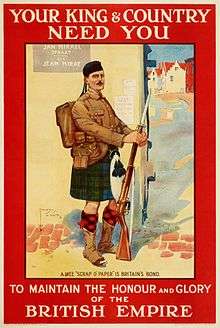Lawson Wood
| Lawson Wood | |
|---|---|
| Born |
23 August 1878 Highgate, London, England |
| Died |
26 October 1957 (aged 79) Honiton, Devon, England |
| Nationality | United Kingdom |
| Other names | Clarence Lawson Wood |
| Occupation | Painter, illustrator and designer |
Lawson Wood, sometimes Clarence Lawson Wood, (23 August 1878 – 26 October 1957), was an English painter, illustrator and designer known for humorous depictions of cavemen and dinosaurs, policemen, and animals, especially a chimpanzee called Gran'pop, whose annuals circulated around the world. Wood was decorated by the French for his gallantry at Vimy Ridge during World War I. He was deeply concerned with animal welfare and was awarded membership in the Royal Zoological Society in 1934. His animal designs were reproduced as wooden toys and he established a sanctuary for aged creatures. In his later years, he was a recluse and died in Devon in 1957.
Biography

Lawson Wood was born on 23 August 1878 in Highgate, London, the son of landscape artist Pinhorn Wood,[1] and the grandson of architectural artist L.J. Wood. He studied at the Slade School of Fine Art, Heatherley's School of Fine Art and Frank Calderon's School of Animal Painting.[2]
In 1896, he was employed with periodical publisher C. Arthur Pearson Ltd.[1] In 1902, he married Charlotte Forge. From the age of 24 he pursued a successful freelance career and was published in The Graphic, The Strand Magazine, Punch, The Illustrated London News, and Boys Own Paper. He illustrated a number of books including Louis Tracy's The Invaders in 1901 for Pearson.[2]
By 1906, he was recognized for his humorous style, especially for his depictions of stone-age humans and dinosaurs. His standing among artists was made obvious when he was chosen by art instructor Percy V. Bradshaw to launch The Art of the Illustrator, a collection of twenty portfolios demonstrating six stages of a single painting or drawing by twenty different artists.[2]
Wood was a member of the London Sketch Club,[1] and a close friend of fellow member Tom Browne whose influence is clearly seen in his work. He was elected a member of the Royal Institute of Painters in Watercolours and exhibited with Walker's Galleries, Brook Street Art Gallery, and the Royal Academy.[2]
During World War I, Wood served as an officer in the Kite Balloon Wing of the Royal Flying Corps,[1] and was responsible for spotting planes from a hot-air ballon. The duty was dangerous, and Wood was decorated by the French for his action over Vimy Ridge. Wood's patriotic designs were published by Dobson Molle & Co.[2]
After the war, his animal designs were published by Inter-Art and Valentine, and his bird, animal, and human designs were reproduced as a line of wooden toys known as "The Lawson Woodies".[2] In 1934, he was awarded a fellowship of the Royal Zoological Society for his work with animals and his concerns about their welfare.[1] He established his own sanctuary for aged creatures. The ape Gran'pop brought Wood fame abroad and the Gran'pop's Annuals were circulated around the world. An animated film was planned around Wood's characters and designs at Ub Iwerks' Hollywood studio but was scuttled with the outbreak of World War II.[2]
His books include The Bow-Wow Book (1912), Rummy Tales (1920), The Noo-Zoo Tales (1922), Jolly Rhymes (1926), Fun Fair (1931), The Old Nursery Rhymes (1933), The Bedtime Picture Book (1943), Meddlesome Monkeys (1946), Mischief Makers (1946), and others.[1]
Wood was a recluse during his later years and dwelt in a 15th-century medieval manor house he moved brick by brick from Sussex to the Kent border.[1] He died in Devon on 26 October 1957 at the age of 79.[1]
References
- Footnotes
- Works cited
- Dalby, Richard (1991), The Golden Age of Children's Book Illustration, Gallery Books, ISBN 0-8317-3910-X
- Smith, Jayne Felicity (2003), Lawson Wood, retrieved 7 September 2010
External links
- Lawson Wood on Artnet
- Lawson Wood artworks
- Lawson Wood at Library of Congress Authorities, with 6 catalogue records
